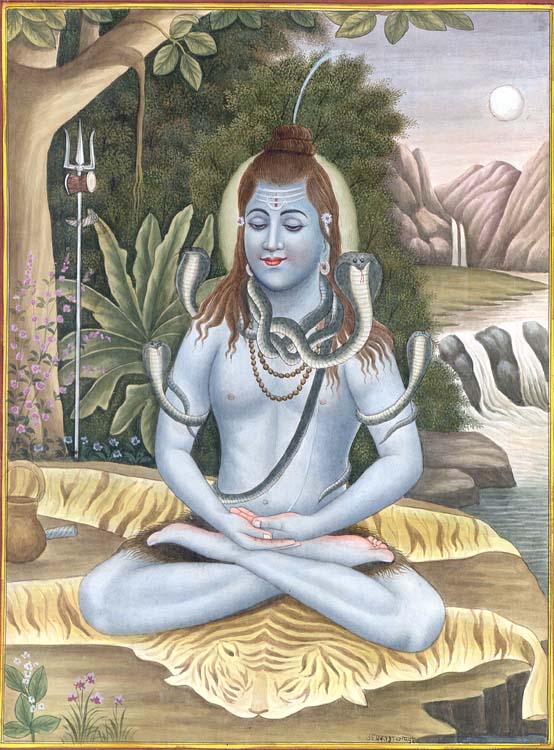Shiva and Prana Yoga
Prana Yoga is one of the most important Yoga traditions and an integral part of the worship of Shiva Mahadev, who represents the highest immortal Prana of pure consciousness beyond time, space and karma. Shiva is the great or Mahaprana, the primordial or Pranapranava and the light of Prana, Prana-Jyoti. That is why he is Mrityunjaya or the Conqueror of death, and holds all the healing Pranas as well.
Shiva and the Unitary Prana
Shiva is the unitary prana behind the dualistic movements of the breath as inhalation and exhalation and the dualistic movements of the mind through attraction and repulsion. To reach the higher Prana of Shiva we must first balance the ordinary dualities of prana, energy and emotion within ourselves. This is not an easy task and requires that we develop a power of concentration, attention and detachment relative to the body, senses and mind. The unitary Prana is also developed by Mantra.
This unitary prana flows in a state of balance and peace, composure and claim. If we can merge into that unitary prana we can go beyond the breath, which is to go beyond life and death. The unitary Prana of Shiva is the prana of prana, the breath behind the breath. The unitary breath of Shiva pervades all space and light. It is the basis of the universal life. It is the very breath of Brahman and the breath of Consciousness. It is this unitary Prana that moves through the Sushumna and activates Kundalini and all the chakras, coming to rest in the thousand petal lotus of the head (Sahasrar) beyond all death, duality and sorrow.
Sounds of the Breath as Sounds of Shiva
The breath reflects certain natural sounds that connect to certain letters of the alphabet. Most important of pranic sounds are the s-sounds and h-sounds that have a hissing or air type quality, such as the yogic Prana mantra SO’HAM. Inhalation as a drawing in of energy reflects the mantra So, while exhalation and the release of energy marks the mantra Ham. So indicates receptive or lunar energy, while Ham reflects projective or solar energy. SO’HAM is also a Shiva mantra.
The Yogi works to balance the SO’HAM current within. This can be done in two primary ways. The first is to expand these natural energies with SO as inhalation and HAM as exhalation. The second is to reverse these energies with HAM as inhalation and SA as exhalation, the Hamsa mantra. The So’ham approach reflects a nurturing lunar energy. The Hamsa approach reflects a purifying solar energy. Both have their places in Yoga practice. Shiva is not only So’ham but also Hamsa.
Once inhalation and exhalation are balanced, they become withdrawn into an inner peace. Then these same sounds “Hamsa So’ham” continue to reverberate within the spine and the sushumna as the natural sounds of the Self, SO’HAM “He am I,” and HAM SA,” I am He,” referring to the Supreme Self. These sounds can also develop into SHIVO’HAM, “I am Shiva.” This is the inner flow of the non-dualistic breath, which is the breath of Shiva.
Shiva Prana Yoga Practices
There are many Prana Yoga traditions connected to Lord Shiva. They are reflected in several Yoga practices.
Nadi Shodhana
Alternate nostril breathing is the main practice for balancing the pranic energies within us. It can be used to balance the right and left or solar and lunar nadis, as well as the Agni and Soma energies in the body overall or in the different chakras. Use the mantra HAM for breathing through the right nostril and SA or SO for breathing through the left (So for inhalation and Sa for exhalation).
Hamsa So’ham Pranayama
As Shiva is prana, the natural sound of the breath is the Name of Shiva. Follow the natural sounds of the breath as HAMSA or SOHAM, “He am I” or “I am He” (referring to our Shiva nature). Or simply SHIVOHAM or I am Shiva. HAMSA is more solar and SO’HAM more lunar in its energy. The same mantras can be used to hold the Prana in the Sushumna. Internally chant HAMSA SO’HAM while meditating in silence and holding the awareness in the spine.
Yoga Nidra – the Sleep of Shiva
This consists of withdrawing into our inner core prana and consciousness or the state of Shiva that holds all knowledge and all power. It is the ultimate practice of Pratyahara. It requires that we merge our senses and mind into our prana that is withdrawn into the hridaya or the spiritual heart. This is a much deeper level of practice of Yoga Nidra than what is usually taught today under the name.
The Breath of the Witness – Sakshi Prana
Consciously observing the breath, one moves into the state of the seer, which is the immortal witness beyond the breath. One enters into the unitary power of consciousness that is beyond birth and death, breath and no breath. Learn to recognize your inner awareness as the breath behind the breath. You do not breathe. It is the body and the lungs that breathe. You are the awareness and energy behind the breath and not limited to its fluctuations.
Finally, we can just merge into Lord Shiva as Mrityunjaya, the conqueror of sorrow, death, and rebirth, either through devotional surrender or recognition of the Supreme Shiva or the Supreme Self as our true nature. This is the basis of the famous Vedic Mrityunjaya Mantra.
Vamadeva (David Frawley)







